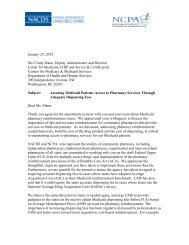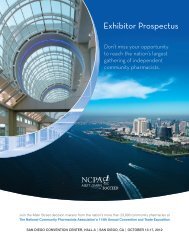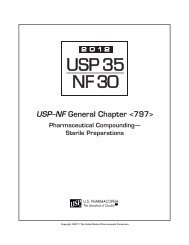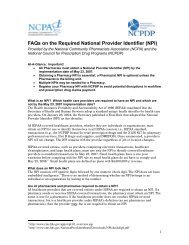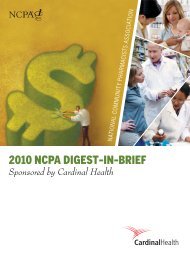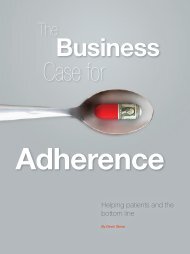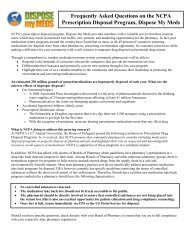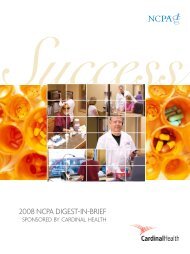NATIONAL COMMUNITY PHARMACISTS ASSOCIATION
NATIONAL COMMUNITY PHARMACISTS ASSOCIATION
NATIONAL COMMUNITY PHARMACISTS ASSOCIATION
- No tags were found...
Create successful ePaper yourself
Turn your PDF publications into a flip-book with our unique Google optimized e-Paper software.
Operating Results To determine how the participating pharmacies performedfinancially, the financial information from the survey wassummarized and presented in three basic statements: common-sizedincome statement, median financial benchmarks,and common-sized balance sheet. These statementsare provided in Tables 2, 3, and 4, respectively. From thesetables, we have provided a summary of the results.2008 Highlightsn Average sales for all participating pharmacies was over9.7 percent higher than sales for the Top 25 Percent,suggesting that smaller pharmacies are maintainingcosts and generating profits more efficiently than largerpharmacies.n Gross margin remained constant as in 2007 at 23.2percent for all pharmacies. The Top 25 Percent experienceda decrease in gross profit margin of 0.9 percentagepoints; however, they still had higher gross marginsthan all pharmacies (at 24.5 percent compared to 23.2percent for all pharmacies).n Median net operating income decreased by 0.27 percentage Over the past few years, gross profit margins have slightlypoints to 2.70 percent, and yet the median net operating increased or decreased from year to year. For 2008, grossincome dollars for 2008 stayed basically the same as 2007. profit margins remained constant at 23.2 percent. It appearsthat independent community pharmacy owners The Top 25 Percent experienced an increase in median netoperating income percentage and an increase in $101,172 in attempt to maintain a gross margin of 23 percent in ordermedian net operating income dollars before tax. to maintain their business.n Return on investment for all pharmacies decreased from30 percent to 23 percent in 2008.n For all pharmacies and the Top 25 Percent, the currentratio and quick ratio increased, indicating more liquidityand less potential for cash flow problems. This may be dueAll Pharmacies to the improved reimbursement time for Medicare PartD plans and independent pharmacists’ ability to adapt tocash flow problems.ProfitabilityThe charts below show what happens to each sales dollarfor the “average” pharmacy versus the average independentcommunity pharmacy in the top 25 percentile.The Top 25 Percent have 7.1 percent in net operatingincome (compared to 3.2 percent, the average for allpharmacies). To assess the real impact of their operatingefficiency, apply this 3.9 percent difference to average salesof $3.8 million for all pharmacies. The result is more than$148,000 of added operating income dollars if the expensecontrols of the Top 25 Percent can be met. Their profit advantagecomes from managing cost of goods sold, payrollexpenses, and other operating expenses.Gross Profit MarginThe Top 25 Percent have a 1.3 percent gross profit advantageby managing cost of goods sold and pricing. Theirgross profit margin was 24.5 percent compared to 23.2 percent for all participating pharmacies. Still, the Top 25Percent saw gross profit margins as a percentage of sales fallTop 25 percent 102009 NCPA Digest, sponsored by Cardinal Health



